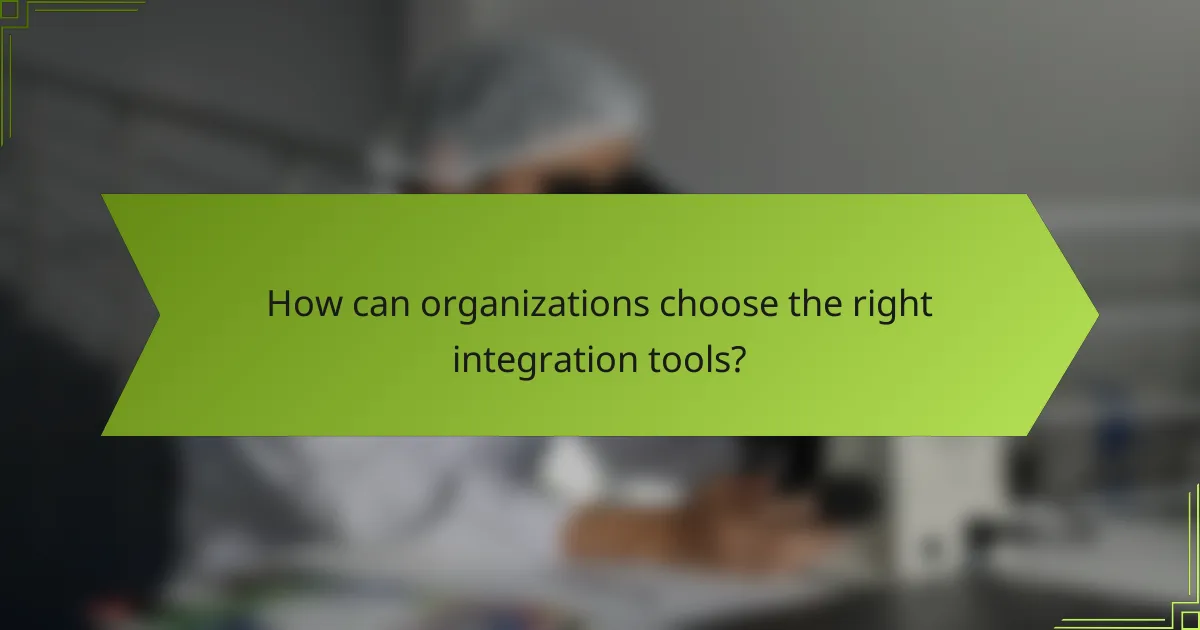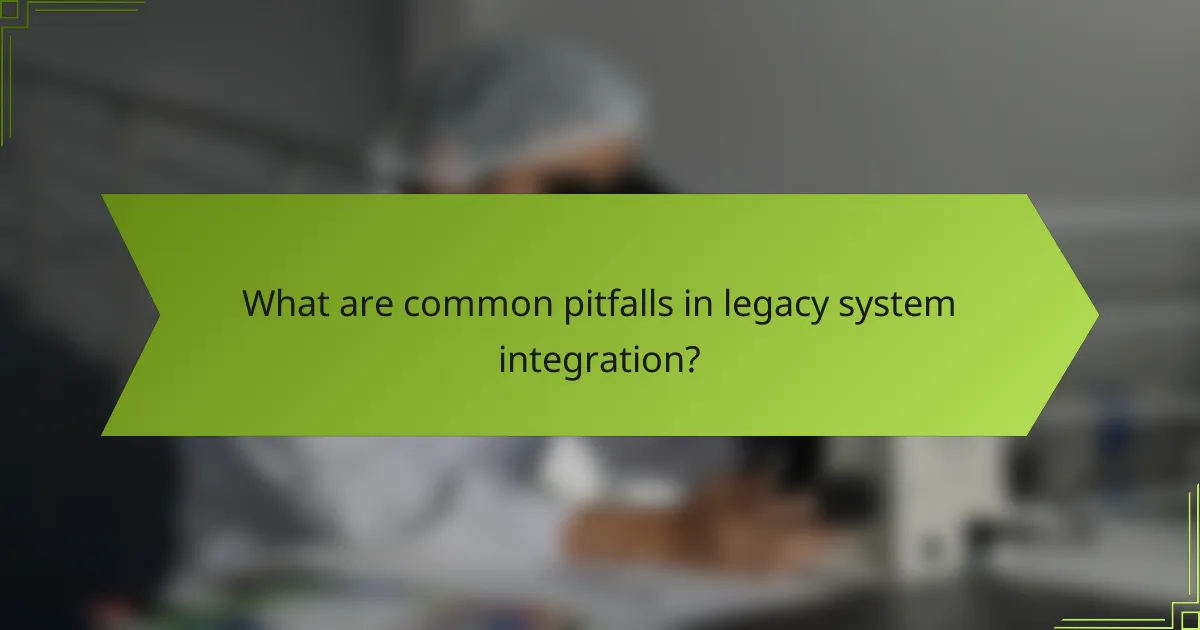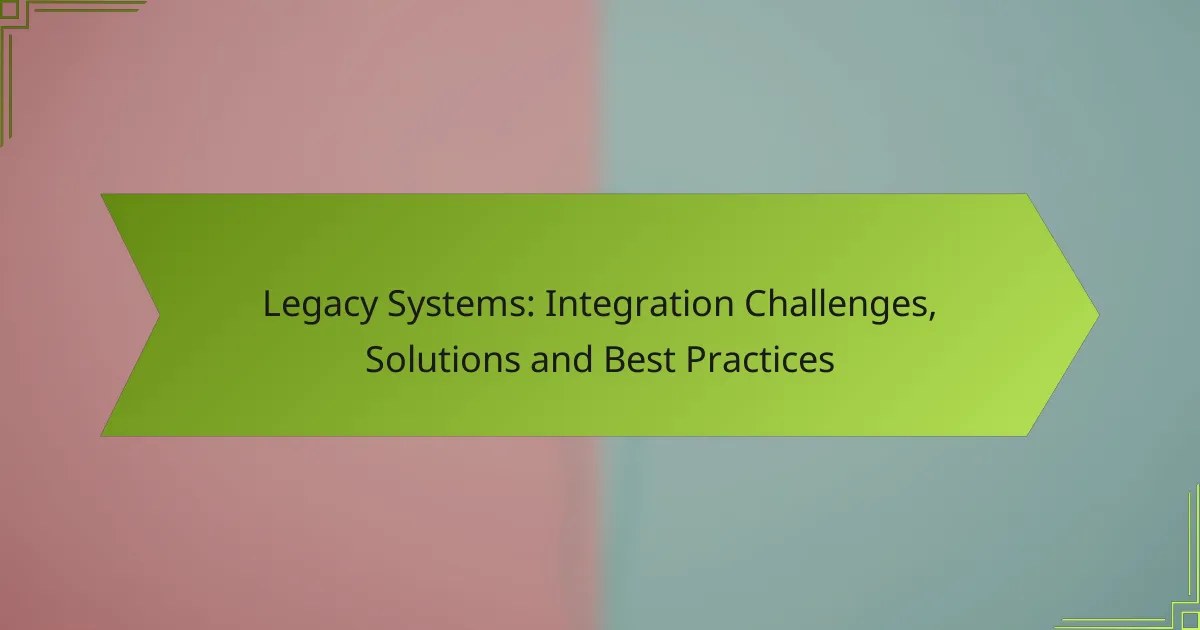Legacy systems present significant integration challenges that can impede their functionality with modern technologies, leading to inefficiencies and increased costs. To navigate these obstacles, organizations must adopt strategic approaches that prioritize compatibility and minimize disruption. Implementing best practices such as thorough assessments and phased integration can facilitate smoother transitions and enhance overall system performance.

What are the integration challenges of legacy systems?
Legacy systems often face significant integration challenges that hinder their ability to work seamlessly with modern technologies. These challenges can lead to inefficiencies, increased costs, and security risks, making it essential for organizations to address them effectively.
Data silos
Data silos occur when information is isolated within different legacy systems, preventing easy access and sharing across the organization. This fragmentation can lead to inconsistent data, making it difficult to derive insights or make informed decisions. To mitigate this, consider implementing data integration tools that can consolidate information from various sources into a unified view.
Organizations should also promote a culture of data sharing and collaboration to break down these silos. Regular audits of data access and usage can help identify areas where integration is lacking.
Compatibility issues
Compatibility issues arise when legacy systems cannot effectively communicate with newer technologies or platforms. This can be due to outdated protocols, file formats, or programming languages that are no longer supported. To address these issues, organizations may need to invest in middleware solutions that facilitate communication between disparate systems.
Additionally, consider gradually upgrading legacy systems to more compatible versions or platforms that support modern integration standards. This approach can reduce long-term costs and improve overall system performance.
High maintenance costs
Maintaining legacy systems can be costly due to the need for specialized skills and outdated hardware. Organizations often face rising expenses as they struggle to keep these systems operational while also ensuring compliance with current regulations. To manage these costs, evaluate the total cost of ownership for legacy systems versus potential upgrades or replacements.
Implementing a phased approach to modernization can help spread costs over time while gradually transitioning to more efficient solutions. Regularly reviewing maintenance contracts and vendor agreements can also uncover opportunities for cost savings.
Security vulnerabilities
Legacy systems often have outdated security measures, making them susceptible to cyber threats. As technology evolves, older systems may not receive necessary updates or patches, increasing the risk of data breaches. Organizations should conduct regular security assessments to identify vulnerabilities in their legacy systems.
Implementing additional security layers, such as firewalls or intrusion detection systems, can help protect these systems. Additionally, consider developing a comprehensive security strategy that includes plans for phasing out or upgrading vulnerable legacy systems.
Limited scalability
Legacy systems typically lack the scalability required to support growing business needs. As organizations expand, these systems may struggle to handle increased workloads or integrate with new applications. To address scalability issues, assess the current architecture of legacy systems and identify bottlenecks that hinder performance.
Adopting cloud-based solutions or modular architectures can provide the flexibility needed for growth. Organizations should also plan for future scalability during system upgrades to ensure that new solutions can accommodate changing demands.

What are the best practices for integrating legacy systems?
Integrating legacy systems effectively requires a strategic approach that minimizes disruption while maximizing compatibility with modern technologies. Best practices include thorough assessments, middleware utilization, phased integration, and prioritizing data migration.
Conduct a thorough assessment
A comprehensive assessment of existing legacy systems is crucial for understanding their architecture, functionality, and limitations. This evaluation should identify critical components, dependencies, and potential integration challenges.
Involve stakeholders from various departments to gather insights on how legacy systems impact operations. Documenting these findings will help prioritize integration efforts and allocate resources effectively.
Utilize middleware solutions
Middleware acts as a bridge between legacy systems and modern applications, facilitating communication and data exchange. Implementing middleware can simplify integration by providing a standardized interface for disparate systems.
Consider options like Enterprise Service Buses (ESBs) or API gateways, which can help streamline processes and reduce the need for extensive code changes. Choose middleware that aligns with your existing technology stack to ensure compatibility.
Implement phased integration
Phased integration allows organizations to gradually transition from legacy systems to new solutions, reducing risks associated with a complete overhaul. Start with less critical components to test integration strategies and refine processes.
Establish clear milestones and timelines for each phase, ensuring that each step is thoroughly evaluated before proceeding. This approach minimizes disruptions and allows for adjustments based on real-time feedback.
Prioritize data migration
Data migration is a critical aspect of integrating legacy systems, as it ensures that valuable information is transferred to new platforms without loss. Prioritize data quality by cleansing and validating data before migration.
Utilize automated tools to facilitate the migration process, which can help reduce errors and speed up the transition. Regularly back up data and maintain a rollback plan to address any issues that may arise during migration.

How can organizations choose the right integration tools?
Organizations can choose the right integration tools by evaluating compatibility, user experience, vendor support, and total cost of ownership. These factors help ensure that the selected tools meet both current and future integration needs effectively.
Evaluate tool compatibility
Compatibility is crucial when selecting integration tools, as they must work seamlessly with existing legacy systems and other software. Organizations should assess whether the tools support relevant protocols, APIs, and data formats used in their environment.
Conducting a compatibility audit can help identify potential integration issues. For example, if a legacy system uses specific database technologies, the chosen tool should support those to avoid costly workarounds.
Consider user experience
User experience plays a significant role in the adoption and effectiveness of integration tools. Tools should have intuitive interfaces that facilitate easy navigation and reduce the learning curve for staff.
Gathering feedback from end-users during the selection process can provide insights into usability. Prioritize tools that offer customization options to tailor the experience to specific organizational needs.
Assess vendor support
Strong vendor support is essential for troubleshooting and ongoing maintenance of integration tools. Organizations should evaluate the level of support offered, including response times, availability of documentation, and access to training resources.
Consider vendors with a proven track record in the industry and positive customer reviews. A reliable support system can significantly reduce downtime and enhance overall integration success.
Analyze total cost of ownership
The total cost of ownership (TCO) includes not only the initial purchase price but also ongoing costs such as maintenance, training, and potential upgrades. Organizations should calculate TCO to understand the long-term financial implications of their integration tools.
Compare the TCO of different tools by considering factors like subscription fees, licensing costs, and any hidden expenses. This analysis helps in making informed decisions that align with budget constraints while ensuring effective integration capabilities.

What are the benefits of modernizing legacy systems?
Modernizing legacy systems offers significant advantages such as improved operational efficiency, enhanced security measures, better data analytics capabilities, and increased agility in responding to market changes. These benefits can lead to reduced costs and improved service delivery for organizations.
Improved efficiency
Modernizing legacy systems can streamline processes and reduce operational bottlenecks. By integrating newer technologies, organizations can automate repetitive tasks, leading to faster workflows and improved productivity.
For example, transitioning from a paper-based system to a digital platform can cut processing times from days to mere hours. This efficiency not only saves time but also reduces labor costs, allowing staff to focus on higher-value activities.
Enhanced security
Legacy systems often lack the robust security features needed to protect sensitive data from modern threats. By updating these systems, organizations can implement advanced security protocols, such as encryption and multi-factor authentication.
Regular updates and patches are crucial to maintaining security. Organizations should consider adopting cloud solutions that offer built-in security features, ensuring compliance with regulations like GDPR or HIPAA, depending on their industry.
Better data analytics
Modern systems enable organizations to collect and analyze data more effectively. By leveraging advanced analytics tools, businesses can gain insights into customer behavior, operational performance, and market trends.
For instance, integrating a modern analytics platform can help a retail company track sales patterns in real-time, allowing for timely adjustments in inventory and marketing strategies. This data-driven approach can significantly enhance decision-making processes.
Increased agility
Modernizing legacy systems enhances an organization’s ability to adapt to changing market conditions. With flexible architectures, businesses can quickly implement new features or pivot strategies without extensive downtime.
For example, a financial institution that modernizes its systems can rapidly deploy new services in response to regulatory changes or customer demands, maintaining a competitive edge. This agility is essential in today’s fast-paced business environment.

What are common pitfalls in legacy system integration?
Common pitfalls in legacy system integration include data silos, lack of documentation, and inadequate testing. These challenges can lead to inefficiencies, increased costs, and project delays, making it crucial to address them early in the integration process.
Data Silos
Data silos occur when information is isolated within different systems, preventing seamless access and sharing. This can lead to inconsistent data and hinder decision-making. To mitigate this, organizations should prioritize creating a unified data strategy that encourages interoperability among systems.
Lack of Documentation
A lack of comprehensive documentation can complicate integration efforts, as teams may struggle to understand legacy systems’ functionalities and dependencies. It is essential to invest time in documenting existing systems and processes to facilitate smoother integration and onboarding for new team members.
Inadequate Testing
Inadequate testing can result in undetected issues that surface post-integration, leading to operational disruptions. Organizations should implement thorough testing protocols, including unit, integration, and user acceptance testing, to ensure that all components work together as intended before going live.
Resistance to Change
Resistance to change from employees can hinder the integration of legacy systems. To address this, it is important to involve stakeholders early in the process, communicate the benefits of integration, and provide training to ease the transition.
Underestimating Complexity
Legacy systems often have complex architectures that can be challenging to integrate with modern technologies. Organizations should conduct a detailed assessment of existing systems to understand their intricacies and plan for potential complications during integration.
